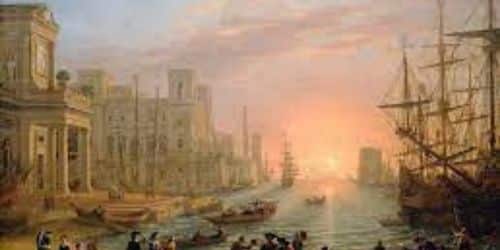A lot of the time, the government used the economy to strengthen state power at the expense of other countries. This process is known as mercantilism. Governments wanted to build up their riches in the form of bullion and make sure that exports outpaced imports. Between the sixteenth and eighteenth centuries, mercantilism was a trade-based economic system. Continue reading for an overview of mercantilism.
Mercantilism
A type of economic nationalism called mercantilism aimed to strengthen a country’s position of strength and prosperity by enforcing unfair trade laws. Its objective was to use exports to increase a state’s gold and silver supply as opposed to using imports to reduce it. Together with it, it aimed to promote domestic employment.
The mercantilism theory said that because the world’s wealth was fixed, governments had to limit trade in order to get richer and have more power. Manufacturers and merchants, like the English and Dutch East India Companies, were the main people that mercantilism cared about when it came to protecting their businesses.
Characteristics of Mercantilism.
These are the major characteristics of mercantilism
#1. Affirming That Wealth is Static
Because precious metals were so rare, people had a narrow view of what it meant to be wealthy. If a country wanted to be wealthy and powerful, it had to hurt other countries to get as rich as possible.
#2. The Requirement to Boost Gold Production
Richness and power were symbolized by gold. Armed forces, resource-seeking maritime expeditions, and rising empires may all be funded by it. Invasion defense is another possibility. A nation’s demise was attributed to a lack of gold.
#3. The Want to Keep a Trade Surplus
A wealth-building strategy required this. Instead of focusing more on importing goods, nations needed to concentrate on selling their exports and generating the related money (and sending gold out of countries).
#4. A Big Population Is Important
Wealth was reflected in the large populations. In order to provide a labor force, support domestic trade, and keep armies in place, a country’s population must grow.
#5. How Wealth is Supported by Colonies
For raw materials, labor, and a means of maintaining control over their wealth, certain countries needed colonies (by selling the colonies the products their raw materials helped to produce). Colonies essentially strengthened a nation’s capacity to create riches and ensure national security.
#6. Usage of Protectionism
Colonies weren’t allowed to trade with other countries, and tariffs were put on imports to keep a country’s ability to make and keep trade surpluses.
History of Mercantilism
In the 1500s, mercantilism first appeared in Europe. It was based on the idea that a country’s wealth and power would be best served by increasing exports and decreasing imports.
Western Europe’s feudal economic structure was supplanted by mercantilism. Despite being the hub of the British Empire at the time, England had very few natural resources.
In order to get richer, England set up fiscal policies that made it easier for colonists to buy only British goods and harder for them to buy goods from other countries. For instance, the Sugar Act of 1764 increased taxes on molasses and refined sugar brought into the colonies from abroad. The British sugar plantations in the West Indies wanted to control the colonial market so they raised taxes.
In a similar vein, the Navigation Act of 1651 prohibited foreign ships from trading along the British coast and mandated that colonial products first go under British control before being divided throughout Europe.
These kinds of initiatives led to a favorable trade balance, which raised Great Britain’s national income.
Under mercantilism, countries often used their military power to protect their own markets and supply chains. According to mercantilists, a country’s possession of valuable metals like gold or silver can be used to gauge the strength of its economy. Their numbers tended to go up when there were more new homes being built, more crops being grown, and a strong merchant fleet that sent goods and raw materials to more markets.
Ideology of Mercantilism
Mercantilism is an economic theory that says the government should control trade with other countries and protect businesses at home. Mercantilist policies prioritize trade surpluses and the protection of domestic businesses through laws. When it comes to international trade, government rules like tariffs and import restrictions are used to create a good trade balance.
On the home front, mercantilist policies help domestic industries by making monopolies and sharing resources to help them grow. These measures are a sort of economic protectionism designed to promote self-sufficiency and are in stark contrast to the free-market economics of trade and globalization.
Criticisms of Mercantilism
The main idea behind mercantilism is that getting gold and other valuable metals is the best way to get rich. Nowadays, we believe that a country’s GDP, or economic output, is what determines how wealthy it is. This is so because of the inability to measure real wealth by how much gold a country owns but by what its labor and land are creating. Mercantilists, meanwhile, favor independence and forbid importation. But, as happened in Spain, some countries are unable to produce enough food to sustain their own populations. Despite having a lot of gold, the bulk of its inhabitants were starving.
If a country can’t meet its own basic needs, it can’t be thought of as wealthy. The state-granted monopolies also discouraged domestic companies from competing. By putting high tariffs and limits on imports, domestic businesses are mostly protected from competition. Because of these pressures, businesses would try to make their factories more efficient so they could make goods for less money.
The attack on imports was on the idea that wealth can’t grow. So, one country’s loss is another’s gain. The assumption is incorrect, though. Adam Smith outlined the cause in his book “A Wealth of Nations.” In this book, Smith defines “comparative advantage” as when one country is better at making Product A than another, but the other country is better at making Product A. Focusing on the goods that each country is best at producing will increase both countries’ output and, hence, their income.
Mercantilism Involves.
- tariff barriers, quotas, or other types of import restrictions.
- building up of gold and silver holdings as well as foreign currency reserves. (also called bullionism) It was thought that the best method to boost a nation’s economy in the sixteenth and seventeenth centuries was to amass gold reserves at the expense of other nations.
- granting specific businesses, particularly those involved in commerce and shipping, state monopolies.
- subsidization of export-oriented sectors in order to get a competitive edge on the world market.
- To maximize the effectiveness and capacity of the domestic sector, the government invests in research and development.
- allowing foreign corporations to steal intellectual property or copyright.
- restricting the wages and spending of the working classes to maintain higher profits for the merchant class
- Control over colonies, such as requiring them to purchase goods from countries in the Empire and seizing control of their wealth.
Examples of Mercantilism
- Foreign ships were not allowed to engage in coastal trade by the England Navigation Act of 1651.
- Every colonial export to Europe had to go through England first before being sent back there.
- India was unable to purchase goods from native producers during the British Empire and was compelled to acquire salt from the UK. Gandhi’s “Salt tax uprising” was sparked by demonstrations against this salt charge.
- The government in seventeenth-century France encouraged a managed economy with stringent rules governing the economy and labor markets.
- Following the Great Depression, protectionist measures became more prevalent as nations sought to cut imports while also devaluing their currencies by abandoning the gold standard.
- China has been charged with mercantilism due to industrial practices that have resulted in an excess of industrial production and a policy of undervaluing the currency.
- The scope of the mercantilist policy, however, is debatable. Take a look at Is China Mercantilist? NBER
Factors of Mercantilism
A number of economic, political, religious, and cultural factors played a role in the rise of mercantilism.
#1. Economic Factors
At the end of the 15th century, the way that people made a living was changing. A trading economy was taking the place of the domestic economy. The industry was taking over from agriculture. Commerce grew in importance and altered the socioeconomic framework of the medieval ages.
#2. Political Factors
Nationalism developed into a potent force around the end of the Middle Ages. The Renaissance had a significant impact on Europe. A profound political shift developed as a result. It caused the rise of powerful nations like England, France, Spain, and others, the end of feudalism, and increased power for the monarch.
#3. Religious Factors
The Reformation Movement was an uprising against the Roman Catholic Church. It questioned the Pope’s position of power. The nation’s political and economic affairs were first under the aegis of the Roman Catholic Church. The contention over the Pope’s authority, however, followed the Reformation.
#4. Cultural Factors
Europe was also experiencing a significant cultural shift. expansion of people’s access to knowledge throughout the Renaissance. persuasion of individuals about mortal existence was more significant than the hereafter. Money began to play a significant role in human activities as a result.
#5. Scientific Factors:
Science and technology have seen significant advancements and breakthroughs. The printing press and the compass were both major discoveries. The compass made it easier to find your way and helped people find new countries.
What Is the Main Idea of Mercantilism?
The main idea behind mercantilism is that a country needs to trade and export more to get richer and stronger. It was a rule of business. The colonial powers of Europe adopted it as their economic strategy. Hence, these policies encouraged colonial expansion and frequently resulted in war. From author to author and over time, mercantilist thought has become more sophisticated.
What Are the 3 Principles of Mercantilism?
The three principles of mercantilism are as follows:
- The global wealth is almost constant.
- The quantity of precious metals in a country is the best indicator of its riches.
- the necessity of promoting exports over imports in order to achieve a favorable trade balance and produce precious metals.
Why Did Countries Use Mercantilism?
Mercantilism is when governments use their economies to gain more power at the expense of other countries. Governments aimed to make sure that exports were more than imports and to amass money in the form of bullion (mostly gold and silver)
Conclusion
Mercantilism ruled supreme for three centuries and was the forerunner of free trade economic ideology. The mercantilism ideology of accumulating financial riches and state power advocated the practice of protectionism to boost export earnings and cut imports. It led to an age of exploration and colonialism as people tried to find raw materials, trade partners they could work with, and ways to share their wealth.
The free-trade doctrine and capitalism have largely displaced mercantilism throughout the world. Still, it can be seen in the tariffs set by the governments of countries that want to make trade with other countries fair (or unfair).
Related Articles
- Balance Of Trade: Explained!!! Meaning, Importance, Formula
- Can Undervalued Currency Boost an Economy?
- CHECKBOOK: Meaning & How to Use It
- HIGHEST PAYING MASTER’S DEGREES: Best Master’s Degrees 2023






